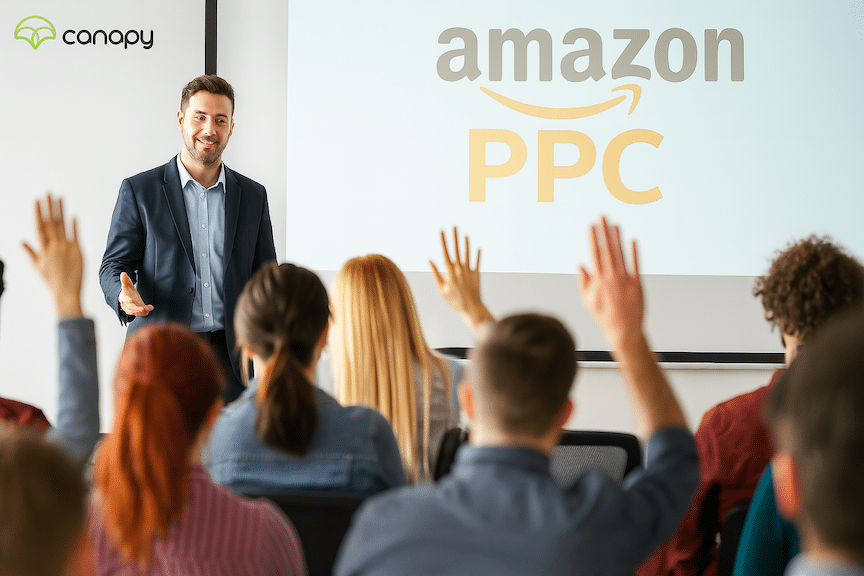Amazon Sponsored Product Ads vs. Sponsored Brand Ads: The 6 Crucial Differences Every Seller Should Know
Understanding which Amazon ad type to use – and when – directly impacts your profitability and growth trajectory on the platform.

Amazon’s advertising ecosystem has evolved significantly, especially with AI-powered campaign optimization rolled out throughout 2025. These advances make both Sponsored Products and Sponsored Brands more effective than ever, but they serve fundamentally different strategic purposes. Sellers who understand these distinctions build more profitable advertising strategies.
The core difference: Sponsored Product Ads drive immediate product sales, while Sponsored Brand Ads build long-term brand equity and customer acquisition. Most successful sellers use both, but the timing, budget allocation, and strategic approach for each differs substantially.
This guide breaks down six critical differences between these ad types. With this understanding, you’ll know exactly when to deploy each format and how to structure your advertising investment for both short-term revenue and sustainable growth.

1. Eligibility: Who Can Use Each Ad Type
Sponsored Product Ads are available to professional sellers, vendors, book vendors, Kindle Direct Publishing (KDP) authors, and agencies. The barriers to entry are minimal—products must be in eligible categories and qualify for the Featured Offer. Even new sellers can start advertising immediately with Sponsored Products.
Sponsored Brand Ads require enrollment in Amazon Brand Registry (or vendor/agency status). This creates a meaningful barrier but unlocks significant advantages beyond advertising access.
Brand Registry requires a registered trademark, which can take 6-12 months to obtain if you don’t already have one. For sellers serious about building a sustainable Amazon business, this investment typically pays for itself through the advanced tools and protections it unlocks.
The practical implication: Every seller starts with Sponsored Products. Adding Sponsored Brands becomes possible only after securing Brand Registry, which should be a priority for brands planning long-term Amazon presence.
2. Ad Placement and Visibility
Sponsored Product Ads appear in multiple high-value locations: top of search results, alongside search results, within search results, and on product detail pages. They blend naturally with organic listings—shoppers often don’t distinguish between sponsored and organic products at first glance.
This “native” appearance is strategically valuable. Sponsored Products capture customers actively searching for solutions, presenting your product as a relevant option at the exact moment purchase intent is highest.
Sponsored Brand Ads command premium real estate above search results, before any organic listings appear. These ads showcase your brand logo, custom headline, and multiple products simultaneously. They can direct traffic either to a curated product selection or to your Amazon Store.
The placement difference is strategic, not just cosmetic. Sponsored Products compete within the search results landscape. Sponsored Brands sit above it, capturing attention before customers begin evaluating individual products. This positioning makes Sponsored Brands particularly effective for new product launches or when building awareness in categories where your brand lacks organic visibility.

3. Ad Structure and Creative Format
Sponsored Product Ads promote individual products using Amazon’s standard listing content: product image, title, price, Prime badge, and review rating. There’s no custom creative—the ad pulls directly from your product listing.
This simplicity is both a strength and limitation. Strength: quick campaign setup with no creative work required. Limitation: your ad looks identical to competitors selling similar products, making differentiation challenging without strong listing optimization.
Sponsored Brands offer creative control through three format options:
Product collection showcases your brand logo, custom headline (up to 50 characters), and three products.
Store spotlight uses similar branding but directs traffic to specific pages within your Amazon Store.
Video format features a single product with video creative, logo, and headline.
This creative flexibility lets you craft a brand narrative beyond individual product features. Sellers with strong brand positioning and visual identity gain disproportionate advantages with Sponsored Brands. Generic or commodity products benefit less from this format.
4. Strategic Purpose: Sales vs. Brand Building
The fundamental strategic difference between these ad types determines when and how to use each.
Sponsored Product Ads drive immediate conversions. These campaigns target customers ready to purchase, appearing precisely when search intent signals buying readiness. Sellers typically optimize Sponsored Products for profitability metrics—specifically Advertising Cost of Sale (ACoS) and Return on Ad Spend (ROAS).
In our work with brands across categories, profitable Sponsored Product campaigns typically run at 15-35% ACoS depending on product margins, though this varies significantly by competitive intensity and product lifecycle stage.
Sponsored Brand Ads prioritize brand awareness, customer acquisition, and long-term loyalty over immediate profitability. These campaigns introduce customers to your brand, often resulting in purchases across multiple products or return purchases over time.
The acceptable ACoS for Sponsored Brands runs higher—often 10-20 percentage points above Sponsored Product campaigns—because the strategic goal differs. You’re investing in customer acquisition and brand recognition, not just individual transactions.
This distinction matters for budget allocation and performance evaluation. Judging Sponsored Brands solely on immediate ACoS misses their strategic value. The better metric: new-to-brand customer acquisition cost and lifetime value.

5. Reporting Capabilities and Optimization Insights
Both ad types provide standard performance metrics: impressions, clicks, click-through rate (CTR), conversions, sales, and ACoS. These metrics enable tactical optimization—pausing underperforming keywords, increasing bids on high-converters, and adjusting targeting.
Sponsored Brand Ads include a critical additional metric: new-to-brand purchases. This tracks orders and revenue from customers who haven’t purchased any products from your brand in the previous 12 months.
New-to-brand metrics reveal:
- Percentage of orders from first-time brand customers
- Total revenue from new customer acquisition
- Customer acquisition cost specifically for brand newcomers
- Which campaigns most effectively grow your customer base
This data transforms how you evaluate campaign performance. A Sponsored Brand campaign with 40% ACoS might look unprofitable until you realize 75% of orders come from new-to-brand customers who typically make repeat purchases. That changes the ROI calculation substantially.
Sellers focused on sustainable growth track new-to-brand acquisition costs closely. In competitive categories, acquiring new customers costs significantly more than generating repeat purchases, making this metric essential for strategic planning.
6. Access to Advanced Amazon Features
Sponsored Product Ads require only a professional selling account. You can launch campaigns immediately after listing products.
Sponsored Brand Ads require Brand Registry, which unlocks an entire ecosystem of advanced selling features beyond advertising:
A+ Content lets you add enhanced product descriptions with rich images, comparison charts, and branded storytelling modules. This typically improves conversion rates by 3-10% in our experience managing hundreds of brands.
Amazon Stores provide a dedicated brand destination within Amazon—essentially a mini-website showcasing your complete product catalog with custom layouts and storytelling. Stores become the landing destination for Sponsored Brand campaigns, letting you control the customer experience beyond individual product pages.
Brand Analytics provides search term reports, market basket analysis, and demographic data unavailable to non-registered sellers.
Sponsored Display Ads and Amazon DSP access unlocks additional advertising formats for retargeting and audience-based campaigns.
The strategic threshold: Brand Registry represents the dividing line between basic Amazon selling and building a defensible brand presence. Sponsored Brands are one component of this larger capability set.

Building an Integrated Advertising Strategy
The most effective approach uses both ad types in coordinated fashion, not as competing alternatives.
Strategic layering approach:
Phase 1: Establish profitability with Sponsored Products Launch Sponsored Product campaigns for your top SKUs. Optimize until you achieve profitable, scalable performance—typically 3-6 months of testing and refinement. This builds baseline revenue and validates product-market fit.
Phase 2: Add Sponsored Brands for customer acquisition Once Sponsored Products profitably generate sales, layer in Sponsored Brand campaigns targeting the same core keywords. Accept higher ACoS on these campaigns in exchange for new-to-brand customer acquisition. Monitor 90-day customer lifetime value to validate the investment.
Phase 3: Expand with brand defense Use Sponsored Brands defensively on your brand name and product names to capture customers specifically searching for your products, preventing competitor ads from appearing above your organic listings.
Budget allocation varies by brand maturity and growth stage, but sellers typically allocate 60-75% of advertising spend to Sponsored Products and 25-40% to Sponsored Brands. Higher brand spend percentages make sense when prioritizing customer base expansion over immediate profitability.
The key insight: these ad types aren’t interchangeable. They serve different strategic purposes in a comprehensive advertising approach. Treating them as alternatives rather than complementary tools limits growth potential.

Frequently Asked Questions
Which ad type should I start with if I have a limited budget?
Start exclusively with Sponsored Product Ads until you achieve consistent profitability. Sponsored Products drive immediate sales with clearer ROI measurement, making them essential for validating your product and advertising approach. Most sellers need 90-120 days of Sponsored Product optimization before adding Sponsored Brands makes strategic sense. The exception: if you’re launching a brand with significant external traffic or social media presence, Sponsored Brands can capture that awareness immediately, but this scenario applies to a minority of sellers.
Can I run both Sponsored Products and Sponsored Brands for the same product?
Yes, and this is exactly what most successful brands do. Sponsored Products capture high-intent searches for immediate conversions. Sponsored Brands introduce your broader product line to new customers. The key is targeting the campaigns differently—use overlapping keywords but evaluate them against different performance goals. Sponsored Products should hit profitability targets, while Sponsored Brands focus on new-to-brand acquisition. Many sellers also use Sponsored Brands defensively on their brand name while Sponsored Products target category and competitor terms.
How much should I allocate to Sponsored Brands versus Sponsored Products?
Budget allocation depends on your growth stage and strategic priorities. New brands typically allocate 80-90% to Sponsored Products until they achieve stable profitability. Established brands often shift to 60-70% Sponsored Products and 30-40% Sponsored Brands. Brands aggressively pursuing customer base expansion might allocate 50-50. The critical factor isn’t the ratio itself but ensuring each campaign type achieves its specific goals—profitability for Sponsored Products, customer acquisition for Sponsored Brands. Start with 80-20 and adjust based on new-to-brand metrics and lifetime value data.
Do I need Brand Registry to be successful with Amazon advertising?
No—many sellers build profitable businesses using only Sponsored Products without Brand Registry. However, Brand Registry significantly expands your strategic capabilities and competitive defensibility. The advertising access alone (Sponsored Brands, Sponsored Display) provides additional growth levers. Combined with A+ Content, Amazon Stores, and brand protection features, Brand Registry represents a meaningful competitive advantage. If you’re building a long-term brand rather than testing products, prioritizing trademark registration and Brand Registry enrollment typically accelerates growth and improves margins.
When should I add Sponsored Brands to my advertising strategy?
Add Sponsored Brands once you’ve achieved three conditions: (1) Brand Registry enrollment, (2) profitable Sponsored Product campaigns running consistently for 60+ days, and (3) a product catalog of 3+ ASINs where cross-selling makes strategic sense. If you’re a single-product brand, Sponsored Brands offer less value until you expand your catalog—though they can still work for brand defense on your product name. The timing matters because Sponsored Brands require higher investment to see meaningful results. Launching them before Sponsored Products are profitable often creates cash flow pressure without delivering proportional returns.
What’s a typical ACoS difference between these ad types?
Sponsored Brand campaigns typically run 10-20 percentage points higher ACoS than Sponsored Product campaigns for the same product or keywords. If your profitable Sponsored Products run at 25% ACoS, expect Sponsored Brands to run 35-45% ACoS targeting similar terms. This reflects their different strategic purposes—Sponsored Products optimize for immediate conversions, while Sponsored Brands pay for awareness and new customer acquisition. The acceptable ACoS difference depends on your new-to-brand customer lifetime value. Track customer cohorts from each ad type to understand the true ROI beyond immediate ACoS.
Can Sponsored Brand Ads work for a single-product brand?
Sponsored Brands can work for single-product brands in limited scenarios, primarily for brand name defense to prevent competitor ads from appearing when customers search your brand. The format loses significant value without a multi-product catalog—you can’t showcase product range or cross-sell effectively. If you’re launching with a single product, focus the advertising budget entirely on Sponsored Products until you expand your catalog. The exception: if you’re a high-margin, high-ticket single product with significant brand awareness from external channels, Sponsored Brands can capture that awareness effectively.
How long until I see results from Sponsored Brand Ads?
Sponsored Brand campaigns typically require 60-90 days to generate meaningful data and optimization insights. The longer timeline compared to Sponsored Products (which often show initial trends in 30-45 days) reflects their strategic nature—you’re measuring customer acquisition and brand awareness, not just immediate conversions. New-to-brand customers often return for subsequent purchases 30-60 days after initial exposure, meaning the full value of Sponsored Brand campaigns emerges over 90-180 days. Start campaigns with a 90-day test budget and evaluate based on new-to-brand metrics and customer lifetime value, not just month-one ACoS.
How Canopy Management Can Help
Navigating Amazon’s advertising ecosystem – coordinating Sponsored Products, Sponsored Brands, and advanced formats like DSP while optimizing for both immediate profitability and long-term growth – requires specialized expertise and significant time investment.
At Canopy Management, we manage comprehensive advertising strategies for brands across Amazon and Walmart. Our team includes former Amazon employees, multi-million dollar sellers, and advertising specialists who have optimized hundreds of campaigns across both ad types.
Our integrated approach includes:
Strategic growth planning that coordinates ad types with your business goals and cash flow requirements. Sponsored Product optimization focused on profitability and scalability. Sponsored Brand management emphasizing customer acquisition and lifetime value. A+ Content and Store design that maximizes conversion from advertising traffic. Cross-platform expansion to Walmart and TikTok Shop when appropriate. Comprehensive analytics tracking performance across traditional metrics and new-to-brand acquisition.
We work as an extension of your team, providing the specialized knowledge and dedicated resources most brands need to maximize Amazon’s advertising opportunities.
Want to understand how coordinated advertising across both ad types could accelerate your brand’s growth? Let’s discuss your specific situation and goals.


